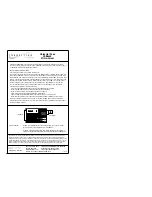
34
OPERATION
Operation
ly sense changes to the bitstream and channel
count and reflect them in these indicators.
Important Note:
When a digital surround
source (Dolby Digital, DTS) is played, the letters
SBL/SBR for the Surround Back channels will
appear only when a DTS ES DISCRETE 6.1 source
is played. Then this surround mode will be indi-
cated in the front display and on-screen display.
With all other recordings the icons for the sur-
round back speakers may light (when those
speakers have been configured) to indicate that a
signal will be fed to them (Matrix decoded with
NEO:6, LOGIC 7 or 7 CH Stereo), but no letters
inside will light as the unit will not receive an
input signal for the surround back channels.
The letters used by the
Speaker/Channel Input
Indicators
E
also flash to indicate when a bit-
stream has been interrupted. This will happen
when a digital input source is selected before the
playback starts, or when a digital source such as
a DVD is put into a Pause mode. The flashing
indicators remind you that the playback has
stopped due to the absence of a digital signal
and not through any fault of the AVR 4550. This
is normal, and the digital playback will resume
once the playback is started again.
Night Mode
A special feature of Dolby Digital is the Night
mode, which enables Dolby Digital input sources
to be played back with full digital intelligibilty
while reducing the maximum peak level and
lifting the low levels by
1
/
4
to
1
/
3
. This prevents
abruptly loud transitions from disturbing others
without reducing the impact of the digital source.
The Night mode is available only when the Dolby
Digital mode is selected.
The Night mode may be engaged when a Dolby
Digital DVD is playing by pressing the
Night
Button
B
on the remote. Next, press the
⁄
/
¤
buttons
D
to select either the middle range or
full compression versions of the Night mode. To
turn the Night mode off, press the
⁄
/
¤
buttons
D
until the message in the lower third of the
video display and the
Lower Display Line
B
reads
D-RANGE OFF
.
The Night mode may also be selected to always
be on as soon as the Dolby Digital mode is
activated at either level of compression using the
options in the
Surround Select
menu.
See page 25 for information on using the menus
to set this option.
IMPORTANT NOTES ON DIGITAL PLAYBACK:
• When the digital playback source is stopped, or
in a pause, fast forward or chapter search mode,
the digital audio data will momentarily stop, and
the channel position letters inside the
Speaker/
Channel Indicators
E
will flash. This is normal
and does not indicate a problem with either the
AVR 4550 or the source machine. The AVR 4550
will return to digital playback as soon as the data
is available and when the machine is in a
standard play mode.
• Although the AVR 4550 will decode virtually all
DVD movies, CDs and HDTV sources, it is possible
that some future digital sources may not be com-
patible with the AVR 4550.
• Note that not all digitally encoded programs
and not all audio tracks on a DVD contain full
5.1 or 6.1 channel audio. Consult the program
guide that accompanies the DVD or laser disc to
determine which type of audio has been record-
ed on the disc. The AVR 4550 will automatically
sense the type of digital surround encoding used,
indicate it in the
Channel Input Indicators
E
and adjust to accommodate it.
• When a Dolby Digital or DTS source is playing,
you normally may not be able to select some of
the analog surround modes such as Dolby Pro
Logic II, Dolby 3 Stereo, Hall, Theater, 5CH/7CH
Stereo or Logic 7, except with specific Dolby
Digital 2.0 recordings that can be played with
the Pro Logic II modes too (see page 33).
• When a digital source is playing, it is possible
to make an analog recording using the
Tape
#
or
Video 1
or
Video 2
or
&
record outputs,
even if the source is connected to any digital
input of the AVR 4550 only, as long as "Surround
Off" mode is selected (possible with a PCM
source only). But the analog two channel signal,
even of a Dolby Digital (not DTS) source, the
”Downmix” to Stereo or Dolby Surround, can be
recorded by connecting its analog audio outputs
to the appropriate analog inputs (e.g. DVD) of
the AVR 4550. Additionally, the digital signals
will be passed through to the
Digital Audio
Outputs
*
.
Tape Recording
In normal operation, the audio or video source
selected for listening through the AVR 4550 is
sent to the record outputs. This means that any
program you are watching or listening to may be
recorded simply by placing machines connected
to the outputs for
Tape Outputs
#
or
Video 1
or
2 Outputs
&
in the record mode.
When a digital audio recorder is connected to
any of the
Digital Audio Outputs
*
, you are
able to record the digital signal using a CD-R,
MiniDisc or other digital recording system.
Note that all digital signals will be passed
through to both, coaxial and optical, digital
outputs simultanously, no matter which kind of
digital input was selected.
NOTES:
• The digital outputs are active only when a digital
signal is present, and they do not convert an ana-
log input to a digital signal, or change the format
of the digital signal (e.g. Dolby Digital to PCM or
vice versa, but coaxial digital signals are converted
to optical signals and vice versa). In additon, the
digital recorder must be compatible with the
output signal. For example, the PCM digital output
from a CD player may be recorded on a CD-R or
MiniDisc, but Dolby Digital or DTS signals may not.
• To make an analog recording from a digital
source is possible, but only from a PCM source
(not Dolby Digital or DTS) and correctly only with
"Surround Off" mode (with any Surround mode
only the L/R front signals will be fed to the record
outputs).
Output Level Adjustment
With Source Signals
Normal output level adjustment for the
AVR 4550 is established using the test tone, as
outlined on page 26. In some cases, however, it
may be desirable to adjust the output levels
using program material such as a test disc, or a
selection you are familiar with. Additionally, the
output level for the subwoofer and those for the
Stereo and VMAx modes can only be adjusted
using this procedure. Note that all adjustments
made with any input will be effective with all
inputs selected, just as it is the case with the
adjustment using the test tone.
To adjust the output levels using program materi-
al, first select the surround mode for which you
want to trim the speakers (see NOTE below), start
your program material source and set the
reference volume for the front left and front right
channels using the
Volume Control
)
î
.
Once the reference level has been set, press the
Channel Select
button
C
Ù
and note that
FRONT L LEVEL
will appear in the
Lower
Display Line
B
. To change the level, first press
the
Set
button
F
@
, and then use the
Selector
buttons
7$
or the
⁄
/
¤
buttons
D
to raise or lower the level. DO NOT use the
volume control, as this will alter the reference
setting.
Once the change has been made, press the
Set
button
F
@
and then press the
Selector
but-
tons
7$
or the
⁄
/
¤
buttons
D
to select
the next output channel location that you wish to
adjust. To adjust the subwoofer level, press the
Selector
buttons
7$
or the
⁄
/
¤
buttons
D
until
WOOFER LEVEL
appears in the
Main Information Display
˜
or on-screen
display (only available if the subwoofer is turned
on).
Press the
Set
button
F
@
when the name of
the desired channel appears in the
Main
Information Display
˜
and on-screen
display, and follow the instructions shown above
to adjust the level.
Repeat the procedure as needed until all chan-
nels requiring adjustment have been set. When
















































